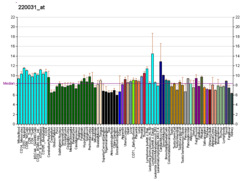| OTUD7B |
|---|
|
| Identifiers |
|---|
| Aliases | OTUD7B, CEZANNE, ZA20D1, OTU deubiquitinase 7B |
|---|
| External IDs | OMIM: 611748; MGI: 2654703; HomoloGene: 10624; GeneCards: OTUD7B; OMA:OTUD7B - orthologs |
|---|
| Gene location (Human) |
|---|
 | | Chr. | Chromosome 1 (human)[1] |
|---|
| | Band | 1q21.2 | Start | 149,937,812 bp[1] |
|---|
| End | 150,010,726 bp[1] |
|---|
|
| Gene location (Mouse) |
|---|
 | | Chr. | Chromosome 3 (mouse)[2] |
|---|
| | Band | 3|3 F2.1 | Start | 96,011,839 bp[2] |
|---|
| End | 96,068,446 bp[2] |
|---|
|
| RNA expression pattern |
|---|
| Bgee | | Human | Mouse (ortholog) |
|---|
| Top expressed in | - buccal mucosa cell
- internal globus pallidus
- sural nerve
- secondary oocyte
- tendon of biceps brachii
- corpus callosum
- inferior ganglion of vagus nerve
- C1 segment
- Skeletal muscle tissue of biceps brachii
- epithelium of colon
|
| | Top expressed in | - blood
- retinal pigment epithelium
- sciatic nerve
- right lung lobe
- neural layer of retina
- spermatid
- lumbar subsegment of spinal cord
- spermatocyte
- triceps brachii muscle
- muscle of thigh
|
| | More reference expression data |
|
|---|
| BioGPS |  | | More reference expression data |
|
|---|
|
| Gene ontology |
|---|
| Molecular function | - DNA binding
- cysteine-type peptidase activity
- zinc ion binding
- metal ion binding
- peptidase activity
- K63-linked polyubiquitin modification-dependent protein binding
- protein binding
- thiol-dependent deubiquitinase
- hydrolase activity
- Lys48-specific deubiquitinase activity
| | Cellular component | - cytoplasm
- nucleus
- cytosol
| | Biological process | - mucosal immune response
- negative regulation of protein localization to nucleus
- protein K48-linked deubiquitination
- protein deubiquitination involved in ubiquitin-dependent protein catabolic process
- immune system process
- negative regulation of transcription by RNA polymerase II
- negative regulation of I-kappaB kinase/NF-kappaB signaling
- proteolysis
- negative regulation of interleukin-8 production
- protein K63-linked deubiquitination
- immune response
- protein deubiquitination
- protein K11-linked deubiquitination
- adaptive immune response
| | Sources:Amigo / QuickGO |
|
| Orthologs |
|---|
| Species | Human | Mouse |
|---|
| Entrez | | |
|---|
| Ensembl | | |
|---|
| UniProt | | |
|---|
| RefSeq (mRNA) | | |
|---|
| RefSeq (protein) | | |
|---|
| Location (UCSC) | Chr 1: 149.94 – 150.01 Mb | Chr 3: 96.01 – 96.07 Mb |
|---|
| PubMed search | [3] | [4] |
|---|
|
| Wikidata |
| View/Edit Human | View/Edit Mouse |
|

















